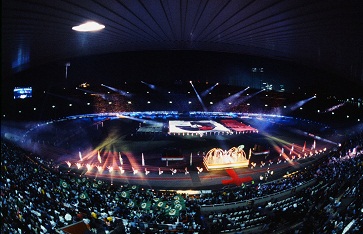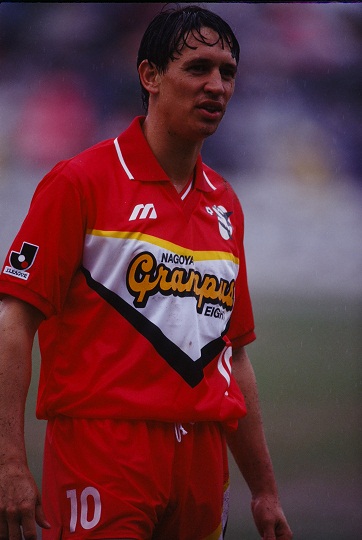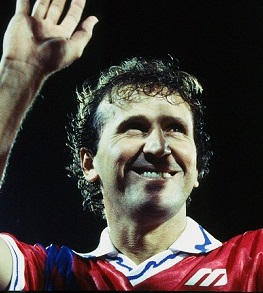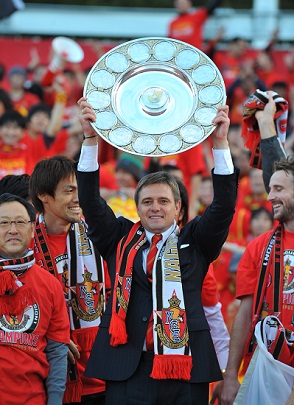| J.League’s 20-year history and the development of sports culture in Japan |
The first ever J.League match kicked off on 15 May 1993, and in 2012, commemorations began for the 20th J. League season. Back in 1993 there were only 10 clubs in the league at first. However, by 1999 the league was split in two (J.League divisions 1 and 2, or J1 and J2) with 18 clubs in J1 and 22 in J2 - a total of 40 clubs. In 2014, division 3 (J3) will be introduced.
|
It is believed that the history of football in Japan can be traced back to 10 years after the establishment of England’s Football Association (FA) in 1863, when the British Navy introduced football to the Japanese Navy. The Japanese Football Association (JFA) was established in 1919 so has a history of more than 90 years. The Japanese national team won the bronze medal in the 1968 Mexico Olympic Games, but failed to make an impact on the world stage - not qualifying for the FIFA World Cup for many years.
In an effort to break the deadlock and raise the level of Japanese football, with the aim of qualifying for the FIFA World Cup, preparations for a Japanese professional football league began in the latter half of the 1980s. Thus 1993 saw the start of the professional Japanese league “J.League”.
|

First J.League football match in 1993
|
|
Establishment of the J.League in 1993 and the progress of Japanese football
Since 1993, several world-famous footballers, such as Brazilian legend Zico and English superstar Gary Lineker, have played in Japan to demonstrate the appeal of the sport. From 1995 to 1996 Arsène Wenger (current manager of Arsenal) was the manager of Nagoya Grampus. Dragan Stojković (from the former Yugoslavia), who played under Wenger at that time, is now the current manager of Nagoya Grampus, and in 2010 his team became J.League champions.
By playing in a professional league, the Japanese footballers were able to improve their football skills, and after a 28 year wait. Japan qualified for the 1996 Olympic Games, followed by their first entry into the FIFA World Cup in 1998. Since this first appearance in 1998, the team has qualified for five successive FIFA World Cup tournaments, including next year’s World Cup in Brazil.
|
 Gary Lineker
Gary Lineker |
 Zico
Zico |
 Stojkovic
Stojkovic |
Ten years after the establishment of the J.League, Japan and Korea co-hosted the FIFA World Cup in 2002. This triggered the development of Japanese stadiums and the areas around them, and both the level of the Japanese game and the facilities were greatly improved as a result.
Since the establishment of the J.League, Japan has become one of the most successful footballing countries in Asia. The Japanese national team have won the AFC Asia Cup, while the Urawa Reds and Gamba Osaka have both won the AFC Champions League.
There are many Japanese footballers who have gone on to play in Europe. Kazuyuki Toda played for Tottenham Hotspur, while Junichi Inamoto played for Arsenal and Fulham amongst other clubs. Shunsuke Nakamura played for Celtic in Scotland and experienced winning the Scottish Premier League with them twice, and in the 2006-2007 season he was voted the Scottish PFA Player of the Year. Park Ji Sung, who made his professional debut at Kyoto Sanga FC, also went on to sign for Manchester United from 2005 to 2012 and contributed to them winning the league several times.
Currently, Tadanari Lee and Maya Yoshida play for Southampton (read our interview with them here), Ryo Miyaichi is under contract with Arsenal and Shinji Kagawa is at Manchester United.
As well as managing a professional football league, the J.League also supports the training and development of young footballers through J.League club academies and by managing the U13 and U14 leagues. Through this means, J.League club academies ensure that there are many new players from which the Japanese national team can be selected. Surely more of them will also go on to play in Europe in the future.
|
J.League’s mission and the reform of Japanese sports culture
The mission of the J.League is not only to develop professional football in Japan and raise the level of the game but also to enable the sport to establish deep cultural roots in Japan.
Before the J.League, the only professional sport, other than individual sports such as sumo, golf and tennis, was baseball. However, professional baseball teams in Japan are owned by private enterprises.
In Japan, students study sports at university or school, and it is usual that those who show competence in their chosen sport continue with it by joining a team owned by a private enterprise. However, this means that if a company’s business performance worsens, sport teams suffer - players cannot continue with their sporting career, or the maintenance of sports teams is no longer justifiable for the company.
For the structure of the J.League, after much study of European and American professional sports, it was decided that each club would be based in a particular town rather than follow the Japanese professional baseball system. The mission was that the professional football league would consist of teams representing specific towns and would become well-loved and supported by the local people.
Until the establishment of the J.League, the amateur Japan Soccer League consisted of business-owned teams, such as Nissan and Toyota, and most of the footballers became employees of those companies and were playing as amateurs.
|
With the J.League, footballers could now belong to clubs as professionals. Teams were made independent of their corporations and became professional teams, known as ‘clubs’. The club names were changed to a combination of the respective town plus a nickname, so Nissan became known as the Yokohama Marinos, Toyota became Nagoya Grampus, and so on. In this way, the J.League aimed not only to encourage the support of the locals but to also contribute to greater sporting achievement in the respective areas.
In Europe, it is not unusual to find teams such as FC Barcelona which are managed according to the ‘socio’ system, whereby sport clubs are funded by membership fees from the local people. Since the J. League has consolidated the home town system, the idea of “local people supporting their local sports club” has spread. At the same time, due to the worsening economic climate in Japan, it seemed as though company sports teams, such as for basketball and ice hockey, might disappear. However, the introduction of local support systems such as the socio system meant that they were able to survive.
More and more J.League clubs began to own teams for other sports. For example, Shonan Bellmare also owns a beach volleyball team which took part in the London Olympic Games. Even for sports other than football, J. League clubs are turning out top-level athletes. |
|
J.League – "The One Hundred Year Vision"
The history of the J.League is very short in comparison its European counterparts, but the league has made great progress over the last 20 years and has slowly been implementing its mission. The J.League has passed its 20-year anniversary mark this year, and it is also a very important year for football as the FA reaches its 150th anniversary this year in the home of football, and we congratulate them most whole-heartedly. The history of the FA is the history of world football.
Since the establishment of the FA in 1863, many people have worked hard to raise the value of this sport and we greatly respect them for that. It will still take considerable time to instil football as part of the culture in Japan in the same way that it is in England after 150 years of history. However, the slogan “The One Hundred Year Vision” was conceived for the J.League three years after its establishment, and is a promise to ensure that our plans for the league will be realised. In the same way that British people have over time developed football to be a sport that is loved worldwide, with the J.League slogan “The One Hundred Year Vision” we hope Japanese citizens will be able to gain continued pleasure through sport, and that Japan and other Asian countries will unite to give football a new profile in the region.
|
Japan Professional Football League (J.League) |
|

